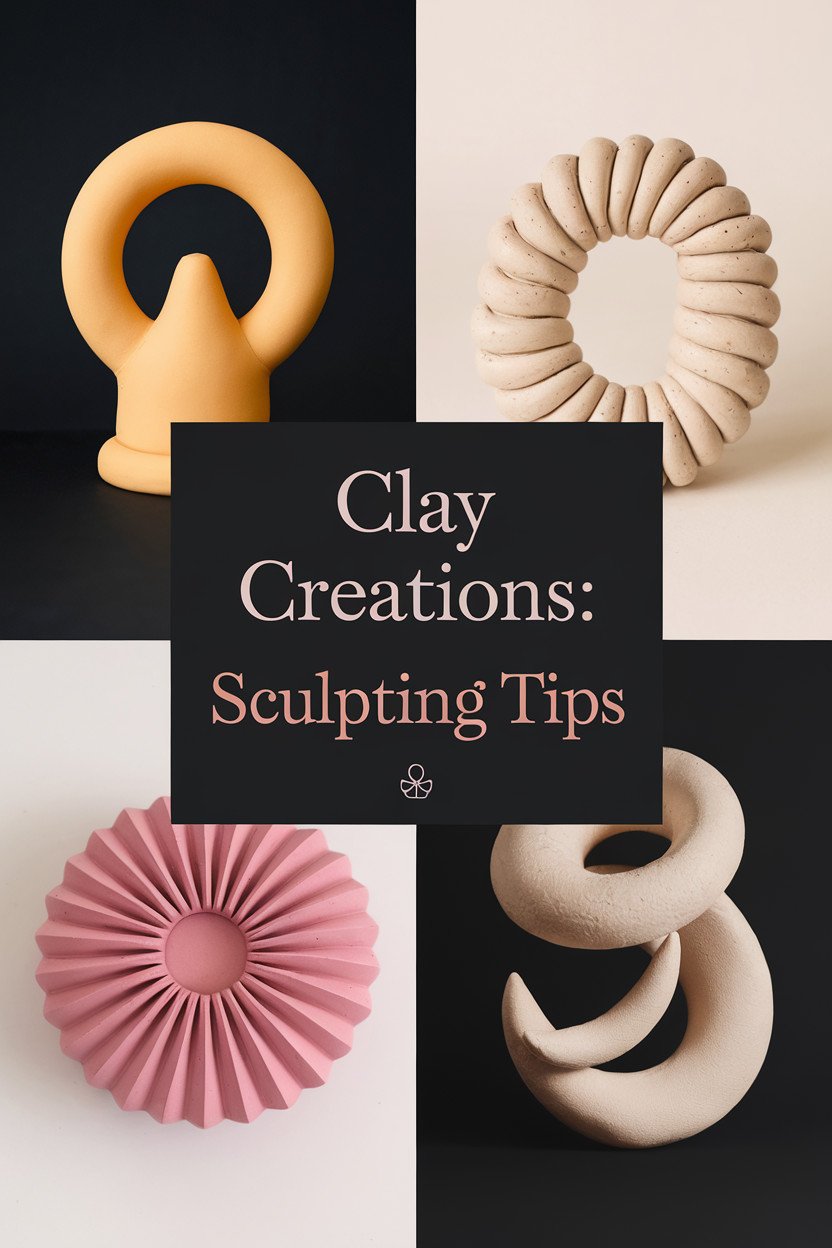If you’re looking for a new creative outlet or want to enhance your sculpting skills, clay sculpting may be just what you need. With its endless possibilities and versatility, sculpting with clay is a fun and rewarding hobby that allows you to unleash your creativity and create stunning masterpieces.
In this article, we will provide you with expert tips and techniques for sculpting with clay. Whether you’re a beginner or an experienced sculptor, you’ll find valuable information to help you take your clay sculpting to the next level. From choosing the right clay to creating realistic textures and enhancing your sculptures with color, we’ll cover everything you need to know to create impressive clay creations.
Key Takeaways:
- Clay sculpting is a fun and rewarding hobby that allows you to unleash your creativity and create stunning masterpieces.
- Whether you’re a beginner or an experienced sculptor, there are valuable tips and techniques to enhance your clay sculpting skills.
- Choosing the right clay, using essential tools, and mastering basic techniques are all crucial for successful clay sculpting.
- Learning how to create realistic textures, sculpt facial features, and explore advanced techniques can help you take your sculpting to the next level.
- Practice, patience, and perseverance are key to becoming a successful clay sculptor.
Getting Started with Clay Sculpting
If you’re new to clay sculpting, welcome to the wonderful world of creating art with your hands! Here are some essential tips to get you started on your clay sculpting journey:
Tools You’ll Need
- Clay: Start with a basic clay that is soft and easy to mold. We recommend oil-based clay or water-based clay for beginners.
- Sculpting tools: You can purchase a variety of tools specifically designed for clay sculpting, or use household items like toothpicks and spoons.
- Work surface: You’ll need a smooth surface to work on, like a table covered with wax paper or a silicone mat.
- Water and sponge: Keep a bowl of water and a sponge nearby to help you smooth out the clay and keep it moist.
Basic Techniques
Before you start sculpting, it’s essential to understand a few basic techniques:
- Pinching: Use your fingers to pinch and shape small pieces of clay.
- Slabbing: Roll out a piece of clay into a flat slab and cut and shape it as desired.
- Coiling: Roll out long, thin pieces of clay and coil them together to make a base shape, then add and shape smaller pieces of clay to build on top of it.
Getting Started
Now that you have your tools and techniques, it’s time to start sculpting! Follow these steps to create your first clay sculpture:
- Choose a design or idea you want to sculpt.
- Create a basic shape using your preferred technique (pinching, slabbing, or coiling).
- Add details using your sculpting tools. Start with larger details and work your way to smaller ones.
- Smooth out any rough spots using a wet sponge.
- Let your sculpture dry overnight or according to the instructions for your chosen clay.
Congratulations! You’ve taken your first steps into the world of clay sculpting. Now, it’s time to practice, experiment and have fun creating unique pieces of art with clay. Remember, practice makes perfect, and with each sculpture you make, you’ll learn new techniques and enhance your skills in no time. Happy sculpting!
Choosing the Right Clay
Selecting the appropriate type of clay is essential for any successful sculpture, but with so many options available, it can be overwhelming for beginners. Here’s what you need to know before you start sculpting:
- Air-dry clay: Easy to use and dries at room temperature. It is ideal for beginners due to its affordability and versatility. However, it is not as durable as other types of clay and can crack if not handled with care.
- Polymer clay: A popular choice for sculpting because of its flexibility, durability, and ability to hold intricate details. It is baked at low temperatures in a home oven and comes in a wide variety of colors.
- Ceramic clay: Suitable for more advanced sculptors. It requires a kiln for firing and can be more expensive. Ceramic clay is ideal for creating permanent and high-quality sculptures.
If you’re a beginner, start with air-dry or polymer clay to get a feel for sculpting. As you gain more experience, you can try your hand at ceramic clay for more complex projects.
Choosing the Right Clay Tips:
- Consider your skill level – choose clay that fits your sculpting abilities.
- Think about your project – different types of clay have specific properties that make them ideal for different projects.
- Experiment with different types of clay – try different clays to see which one works best for your style and preferences.
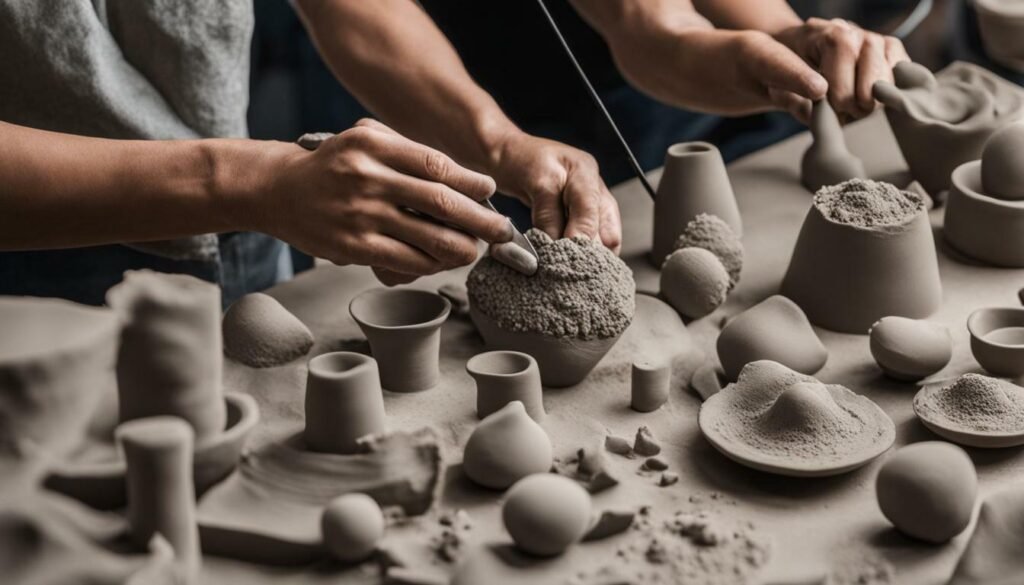
Remember, each type of clay requires different sculpting techniques and tools. Choose your clay wisely and enjoy the process of creating your unique clay sculpture!
Essential Clay Sculpting Tools
Before you start sculpting with clay, it’s important to have the right tools at your disposal. Here are some essential tools that every beginner should have to create stunning clay creations:
- Sculpting knives: These come in various shapes, sizes, and materials, and are used to carve and shape the clay.
- Wire tools: Used for cutting and removing excess clay, wire tools come in various shapes and gauges.
- Shaping tools: These are used for creating smooth surfaces and rounding the edges of your clay sculpture.
- Rolling pins: Used to flatten clay and create uniform slabs or sheets.
- Texture tools: These are used to create different textures in your sculpture, such as scales, fur, or feathers.
Having the right tools will not only improve the quality of your clay sculpture, but it will also make the sculpting process more enjoyable and efficient.
Tips for Choosing Clay Sculpting Tools
When choosing your tools, look for ones that are comfortable to hold and easy to manipulate. Consider the size and weight of the tool, as well as its material and durability. Here are some additional tips:
- Invest in high-quality tools: While it may be tempting to go for cheaper tools, investing in high-quality ones will save you money in the long run and produce better results.
- Consider the type of clay you’ll be using: Different types of clay require different tools. For example, polymer clay may require a different set of tools than ceramic clay.
- Experiment with different tools: Don’t be afraid to try out different tools and techniques to find what works best for you.
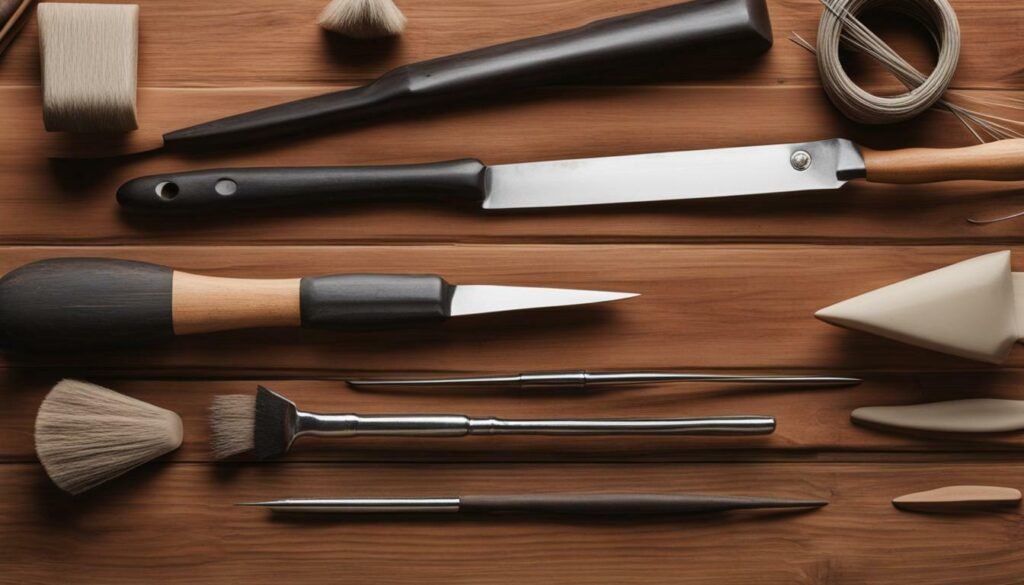
Having the right tools and techniques is the key to creating beautiful and intricate clay sculptures. With patience and practice, you can become a master at clay sculpting and create stunning works of art!
Basic Clay Sculpting Techniques
If you’re new to clay sculpting, learning the basic techniques is essential to creating successful sculptures. Here are some beginner clay sculpting techniques to get you started:
- Pinch technique: Start with a small ball of clay, and pinch it with your fingers to shape it into the desired form. This method can be used to create bowls, vases, and other rounded shapes.
- Slab technique: Roll out a flat piece of clay using a rolling pin or other tool, and cut it into the desired shape. This method can be used to create flat objects such as tiles or plates.
- Coil technique: Roll out long, thin pieces of clay and wind them around each other to create the desired form. This method can be used to create complex shapes such as sculptures or figurines.
Once you’ve mastered these basic techniques, you can start experimenting with combining them to create more complex forms.
Advanced Techniques
Once you’ve mastered the basic techniques, you can move on to more advanced methods of clay sculpting. Here are some ideas:
- Carving: Use carving tools to create intricate designs and textures in your sculptures. This method is ideal for creating detailed designs in your sculptures.
- Molding: Use molds to create multiple copies of the same sculpture. This method is ideal for creating identical copies of sculptures for sale or display.
- Large-scale pieces: Sculpting large-scale pieces requires a different set of skills and techniques. It’s important to have a good understanding of scale and proportion, as well as knowledge of structural support.
With practice and patience, you can master these advanced techniques and create stunning clay sculptures.
Tips for Successful Sculpting
Whether you’re a beginner or an experienced sculptor, these tips can help you create successful clay sculptures:
- Start with a plan: Before you start sculpting, it’s helpful to have a clear idea of what you want to create. Sketch out your design and plan out the steps you’ll need to take to create it.
- Be patient: Sculpting takes time and practice. Don’t rush your work, and be willing to take breaks when you need them.
- Use reference materials: If you’re sculpting a realistic object such as a person or animal, use reference materials such as photographs or drawings to ensure accuracy.
- Experiment with different tools and techniques: Don’t be afraid to try new things and experiment with different tools and techniques. This will help you develop your own unique style.
- Be open to critique: Feedback from other artists can be invaluable in helping you improve your sculpting skills.
With these tips and techniques, you’ll be well on your way to creating stunning clay sculptures.

Adding textures to your clay creations can give them a lifelike feel. Use these techniques to add intricate details that will make your sculptures stand out:
- Create skin textures by rolling and stretching thin sheets of clay onto the sculpture’s surface. Use a toothbrush or sculpting tool to add creases and pores.
- To add fur or feathers, create thin strands of clay and attach them to the sculpture’s surface. Use a sculpting tool to press and shape the strands to create a realistic texture.
- For the appearance of bark, use a sculpting tool to create lines and grooves in the clay’s surface. Then, use a small brush to add darker shades to the grooves, giving them depth.
- To recreate the appearance of stone, use a sculpting tool to create rough lines and speckles. Brush on a mixture of paint and water to create a subtle effect.
Experiment with different techniques to create textures that match your vision. Remember to work with small sections at a time to avoid the clay drying out.

“Take inspiration from the world around you. Observe the textures of different materials and study their appearance. This will give you ideas for creating unique textures that will make your sculptures stand out.
Sculpting Facial Features
Creating realistic facial features is a crucial aspect of clay sculpting. It’s important to have a good understanding of facial anatomy and proportions to achieve a lifelike representation of the human face. Here are some tips and techniques for sculpting facial features:
- Start with a basic head shape: Before adding any facial features, sculpt a basic head shape. This will help you establish the proportions of the face and ensure that your features are placed correctly.
- Focus on the eyes first: The eyes are the focal point of the face, so it’s important to get them right. Use references or mirrors to observe the shape and placement of the eyes, and sculpt them accordingly. Remember to leave space for the eyelids and the tear ducts.
- Shape the nose: The nose is often a challenging feature to sculpt. Start by sculpting the bridge of the nose, and then add the nostrils and flare. The shape of the nose varies greatly, so be sure to observe your reference material carefully.
- Add the mouth and lips: The mouth and lips are essential for conveying emotion in a sculpture. Sculpt the closed mouth shape first and then add the lips, taking care to observe their shape and placement. Etch lines into the lips to indicate the separation between the top and bottom lips.
- Sculpt the ears: Ears can be challenging to sculpt because of their complex shape. Remember that ears are not flat but have a three-dimensional structure. Observe your reference material and take your time to sculpt the details of the ear.
Remember to take breaks and step back from your work to observe your progress. Don’t be afraid to make adjustments as needed to achieve the desired result. With practice and patience, you’ll be able to sculpt lifelike facial features that truly bring your clay creations to life.
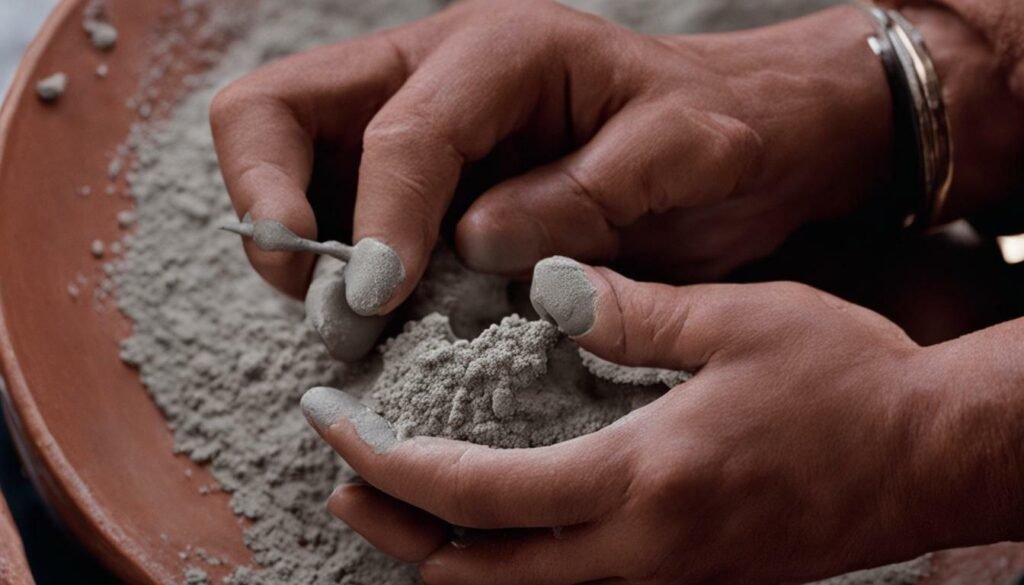
Unleash your creativity by sculpting animals and natural elements. Whether you aim to create a lifelike representation or an abstract interpretation, this section will guide you through the essential techniques to sculpt nature and animal subjects.
Creating Animals
When sculpting animals, it’s essential to capture their unique shapes and textures. Here are some tips to guide you:
- Use reference images to study the animal’s anatomy and details
- Start with a rough outline or armature structure to support your sculpture
- Build up the sculpture’s mass by adding clay to create a basic shape
- Use tools to refine the shape and add details, such as fur, feathers, or scales
- Pay attention to proportion and balance to create a visually appealing sculpture
With practice, you can create stunning sculptures that showcase your skill and creativity.
Exploring Nature Subjects
Nature is a rich source of inspiration for clay sculpting. Create sculptures of flowers, trees, or other naturally occurring objects. Here are some tips to guide you:
- Observe the subject in nature, taking note of its unique shape, texture, and color
- Start with a rough outline or armature structure to support your sculpture
- Build up the sculpture’s mass by adding clay to create a basic shape
- Use tools to refine the shape and add details, such as leaves, branches, or petals
- Pay attention to proportion and balance to create a visually appealing sculpture
With the right technique and creativity, you can create sculpted masterpieces that pay tribute to the natural world.

If you’re looking to push the boundaries of your creative expression, try creating abstract interpretations of animals or nature subjects. Here are some tips to guide you:
- Experiment with different shapes and textures to create a unique interpretation
- Use tools to create varied textures, such as scratching, indentations, or smoothing
- Play with color and finishes to create a visually striking sculpture
- Embrace imperfections and let them add character to your sculpture
- Have fun and let your imagination run wild!
Abstract interpretations can be a fun and non-restrictive way to explore your creativity in clay sculpting.
Enhancing Your Clay Sculptures with Color
Color can add depth and dimension to your clay sculptures. Here are some techniques to enhance your creations:
- Painting: Use acrylic or oil paints for a matte finish or try using metallic or iridescent paints for a shiny effect.
- Glazing: Apply a clear or colored glaze over your sculpture to achieve a glossy finish.
- Using Colored Clay: Mix different colors of clay to create unique color combinations and effects.
- Adding Highlights and Shadows: Use a dry brush technique to add highlights or darken areas with thin washes of paint or colored pencil to create depth and dimension.
- Experimentation: Don’t be afraid to try new techniques and explore different color palettes to create original and eye-catching pieces.
Keep in mind that different types of clay may react differently to coloring techniques, so it’s important to test your colors on a small area first.
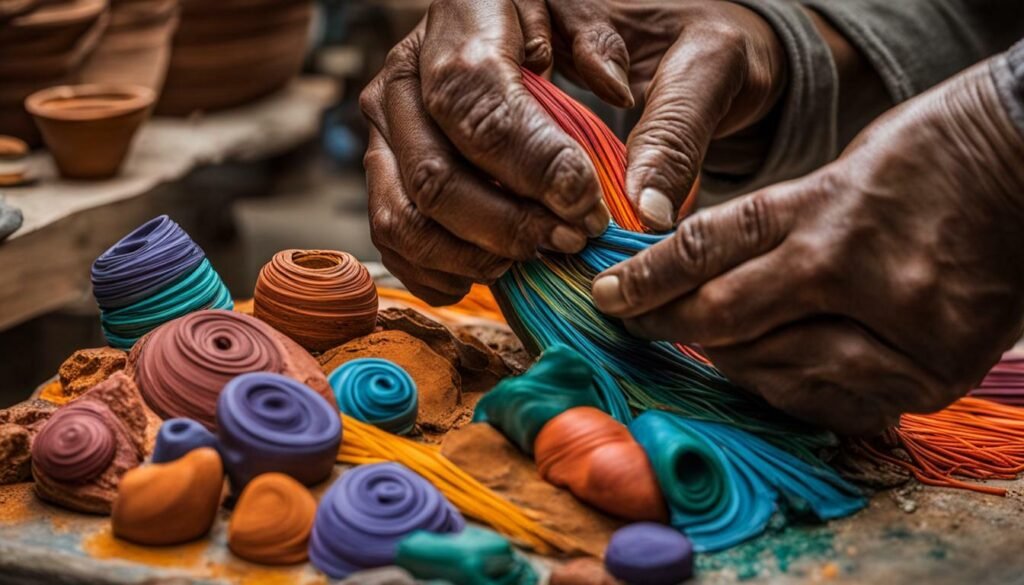
Remember, coloring is a great way to enhance your sculptures, but it’s also important not to overdo it. Sometimes, less is more.
Exploring Advanced Techniques
Congratulations, you’ve mastered the basics of clay sculpting! Now it’s time to explore advanced techniques and take your sculpting skills to the next level. Here are some techniques to keep in mind:
Carving
Carving is a technique used to remove clay and create indentations or grooves that add detail and texture to your sculpture. Use a carving tool, such as a loop tool, to make precise cuts and create intricate designs.
- Start by sketching your design onto the clay surface with a pencil or a marker.
- Make shallow cuts and gradually work your way deeper to prevent cutting too much clay at once.
- Use a brush or damp cloth to clean the surface and remove any loose clay particles.
Molding
Molding is a technique that involves creating a mold of an existing object or sculpture. This technique allows you to replicate the exact shape of an object, or create multiples of the same sculpture. Here’s how to do it:
- Start by selecting an object or sculpture you want to mold.
- Apply a release agent, such as petroleum jelly or cooking spray, to the object to prevent the clay from sticking.
- Wrap the object in a layer of clay.
- Carefully remove the clay from the object, taking care not to distort the shape.
- Fill the mold with clay and allow it to dry before removing it from the mold.
Sculpting Large-Scale Pieces
Creating large-scale pieces requires a different set of techniques and tools. Here are some tips to keep in mind:
- Start with a sturdy armature, such as a wire or metal frame, to provide support for your sculpture.
- Use larger tools, such as a serrated knife or a rasp, to shape and carve the clay.
- Work in sections to prevent the clay from drying out before you can finish the entire sculpture.
- Consider using a scaffold or platform to work on higher sections of the sculpture.
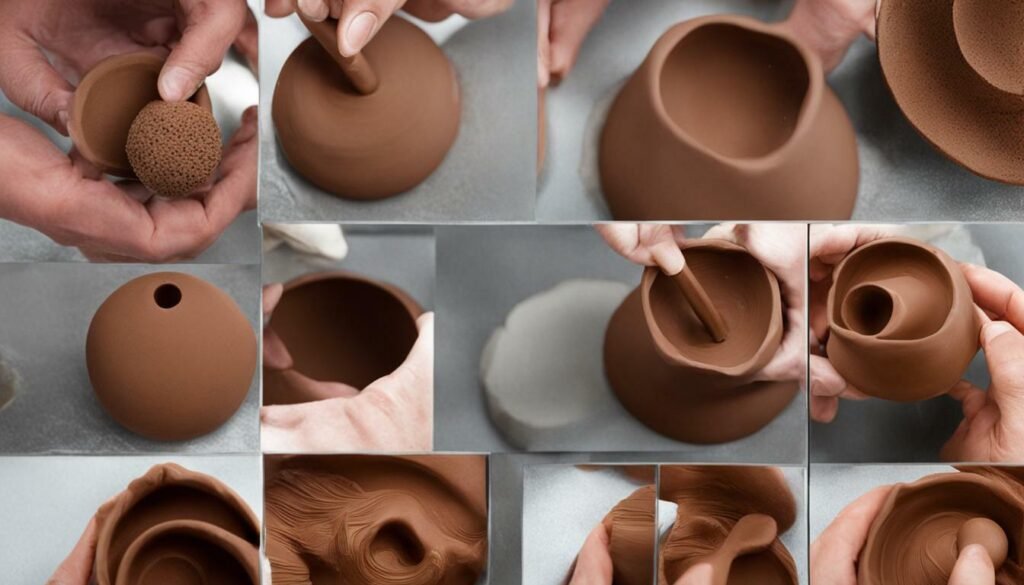
With these advanced techniques, you can take your clay sculpting skills to new heights and create truly remarkable pieces of art. Remember, practice is key to mastering any technique, so keep working on your craft and don’t be afraid to experiment with new ideas!
Troubleshooting Common Issues
As a beginner, it’s common to experience some challenges while sculpting with clay. The good news is that most issues can be easily resolved with some troubleshooting. Here are some common issues you might encounter and how to solve them:
- Cracking: If your clay sculpture is cracking while it’s drying, try misting it with some water and covering it with plastic wrap. This will slow down the drying process and prevent further cracking. You can also try adding some additional clay to the cracked areas and smoothing it out.
- Drying too quickly: If your clay is drying too quickly and becoming difficult to work with, try wrapping it in plastic wrap and placing it in a sealed container or bag. This will help retain moisture and slow down the drying process.
- Achieving a smooth finish: If you’re having trouble achieving a smooth finish on your sculpture, try using a clay smoothing tool or your fingers to gently smooth out any rough spots or bumps. You can also lightly sand the surface with a fine-grit sandpaper after the clay has dried.
Remember, practice makes perfect, and don’t be discouraged if your first few attempts don’t turn out how you envisioned. With some patience and troubleshooting, you’ll soon be creating stunning clay sculptures like a pro!
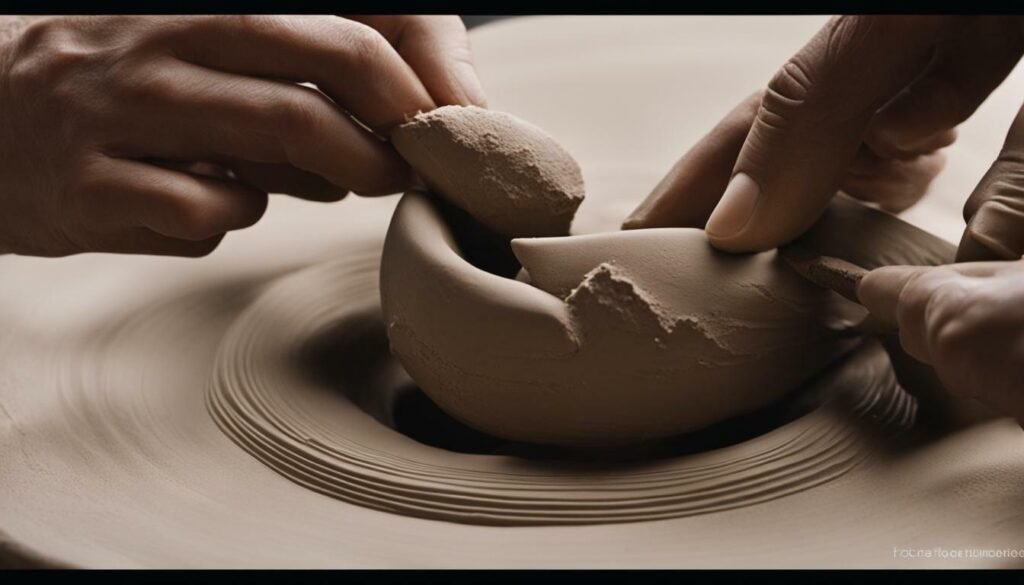
Here are a few more tips to help you troubleshoot any issues you may encounter while sculpting with clay:
- Make sure to work with clay in a cool, dry environment to minimize drying or cracking.
- Keep your tools clean to avoid any unwanted texture on your sculptures.
- If you’re having trouble with a particular technique, try watching tutorial videos or taking a class to improve your skills.
- Experiment with different types of clay to find the one that works best for your specific project.
- If you’re still having trouble, don’t be afraid to reach out to other sculptors or forums for advice.
Remember, troubleshooting is a normal part of the sculpting process, and with some patience and determination, you’ll be able to create beautiful clay sculptures that you can be proud of. Keep practicing and exploring new techniques to unlock your full sculpting potential!
Displaying and Preserving Your Clay Sculptures
Once you have completed your clay sculpting project, you may be wondering how to display and preserve it for years to come. Here are some tips to help you showcase and protect your clay sculptures:
Mounting on a Base or Frame
Consider mounting your clay sculpture on a base or frame to give it a professional look. This will also make it easier to display on a shelf or table. You can purchase pre-made bases or create your own using wood, metal, or other materials. Make sure the base or frame is sturdy enough to support the weight of your sculpture.
Protecting with Varnish or Sealant
To protect your clay sculpture from dust and damage, consider applying a varnish or sealant. This will help to preserve the sculpture’s color and texture. Choose a varnish or sealant that is compatible with the type of clay you used and follow the manufacturer’s instructions for application.
Storing in a Safe Place
When you’re not displaying your clay sculpture, it’s important to store it properly to prevent damage. Avoid placing it in direct sunlight or a humid environment, which can cause the sculpture to warp or crack. Store it in a cool, dry place where it won’t be bumped or knocked over.
Creating a Display Case
If you’re looking for a more elaborate way to showcase your clay sculpture, consider creating a display case. You can purchase a pre-made case or create your own using wood and glass. This will protect your sculpture from dust and damage while allowing you to admire it from all angles.
- Consider adding lighting to your display case to highlight the details of your sculpture.
- Make sure the case is large enough to accommodate your sculpture and any additional items you want to display with it, such as a plaque or description of the sculpture.

By following these tips, you can ensure your clay sculpture remains in excellent condition for years to come. Whether you choose to display it on a shelf or in a custom case, your artwork is sure to impress anyone who sees it.
Clay Sculpting Safety Tips
As a beginner in clay sculpting, it’s important to keep in mind some safety measures to protect yourself and others while creating your art. Follow these tips to ensure a safe and enjoyable sculpting experience:
- Always work in a well-ventilated area to avoid inhaling dust particles from the clay.
- Wear a dust mask to protect your lungs.
- Use tools properly and keep them sharp to avoid injury.
- Handle the clay with care to avoid overexertion and repetitive strain injuries.
- Use gloves when working with certain types of clay, such as polymer clay.
- Keep your work area clean and tidy to avoid slips, trips, and falls.
It’s important to note that some types of clay require special safety considerations. For example, air-dry clay may contain irritants that can cause skin irritation or allergic reactions. Always read the manufacturer’s instructions and safety guidelines before working with a new type of clay.
Another important safety tip is to be aware of the potential dangers of kilns. If you plan to fire your clay creations in a kiln, be sure to follow all safety precautions and operating instructions. Never touch the kiln while it is hot and always wear protective gear, such as heat-resistant gloves and goggles.
By following these safety tips and using common sense, you can enjoy your clay sculpting hobbies while keeping yourself and others safe.

Are you looking for new ideas for your clay sculpting projects? Here are some sources of inspiration to explore:
- Take a walk in nature and observe the shapes, colors, and textures of plants, animals, and landscapes.
- Visit art museums and galleries to discover the works of sculptors and other artists. Observe the techniques they use and the emotions they evoke.
- Explore different cultures and their art forms. Learn about traditional sculptures, pottery, and other crafts and find inspiration in their unique styles.
- Look for inspiration in everyday objects. Observe the shapes and textures of items such as kitchen utensils, toys, and gadgets, and recreate them in clay.
- Get inspired by your favorite books, movies, or TV shows. Create sculptures of characters or scenes that capture your imagination.
Remember, inspiration can come from anywhere, so keep an open mind and let your imagination run wild.
Once you have found your inspiration, it’s time to start planning your project. Consider the following:
- What materials you will need to bring your idea to life.
- The size and scale of your sculpture.
- The level of detail and intricacy you want to achieve.
- The color palette you will use to enhance your sculpture.
- The techniques you will use to create the textures and shapes you desire.
Take your time to plan your project carefully, and don’t be afraid to experiment and make changes along the way.
Remember, clay sculpting is an art form that allows you to express your creativity and imagination. Let your passion guide you and enjoy the journey.

Congratulations on completing this comprehensive guide to clay sculpting techniques and tutorials! We hope you are feeling inspired and ready to dive into the world of sculpting with clay. Remember, your imagination is the limit, and with practice and dedication, you can create stunning pieces of art that reflect your personal style and creativity.
Whether you are a beginner or an experienced sculptor, there is always room to learn and improve your skills. Use the expert tips and techniques in this guide to refine your sculpting process and take your creations to the next level.
Keep These Tips in Mind:
- Choose the right type of clay for your project
- Invest in essential sculpting tools for accurate detailing and texturing
- Master the fundamental sculpting techniques before jumping into advanced methods
- Find inspiration for your sculptures in nature, art, and everyday life
- Practice proper safety measures while handling clay materials
- Display and preserve your sculptures to ensure their longevity
Remember, the art of clay sculpting is a journey of exploration and creativity. Take your time, enjoy the process, and don’t be afraid to experiment with new techniques and ideas. With patience and practice, you can create beautiful and unique sculptures that showcase your artistic talent and passion.
So, what are you waiting for? Grab your clay and sculpting tools and get started on your next masterpiece today!
FAQ
Q: What is clay sculpting?
A: Clay sculpting is the art of shaping and molding clay to create sculptures and three-dimensional artworks.
Q: What types of clay are commonly used for sculpting?
A: The most common types of clay used for sculpting are air-dry clay, polymer clay, and ceramic clay.
Q: What tools do I need to start clay sculpting?
A: Essential tools for clay sculpting include sculpting knives, wire tools, and shaping tools.
Q: What are some basic clay sculpting techniques for beginners?
A: Beginners can start with pinch, slab, and coil methods to shape and mold clay effectively.
Q: How can I add realistic textures to my clay sculptures?
A: Techniques for adding realistic textures include creating lifelike skin textures, fur, feathers, and other intricate details.
Q: How do I sculpt facial features?
A: Sculpting facial features involves learning how to sculpt eyes, noses, mouths, and ears with precision and realism.
Q: Can I sculpt animals and nature with clay?
A: Yes, you can sculpt animals, flowers, trees, and other natural elements to unleash your creativity with clay.
Q: How can I enhance my clay sculptures with color?
A: You can enhance clay sculptures with color through techniques like painting, glazing, and using colored clay.
Q: Are there advanced techniques in clay sculpting?
A: Yes, advanced techniques in clay sculpting include carving, molding, and sculpting large-scale pieces.
Q: How can I troubleshoot common issues in clay sculpting?
A: Troubleshooting common issues in clay sculpting involves finding solutions for problems like cracking, drying too quickly, and achieving smooth finishes.
Q: How do I display and preserve my clay sculptures?
A: You can display and preserve clay sculptures by mounting them on bases or frames and using preservation techniques to ensure longevity.
Q: What safety measures should I follow while clay sculpting?
A: It is important to prioritize safety by following measures such as proper ventilation, safe tool usage, and handling clay materials carefully.
Q: Where can I find inspiration for clay sculpting?
A: Inspiration for clay sculpting can be found in nature, art, culture, and everyday life. Explore various sources to unleash your imagination.
Q: What is the conclusion of this clay sculpting guide?
A: Congratulations on completing this guide! Unleash your creativity with clay sculpting and enjoy the endless possibilities it offers.
